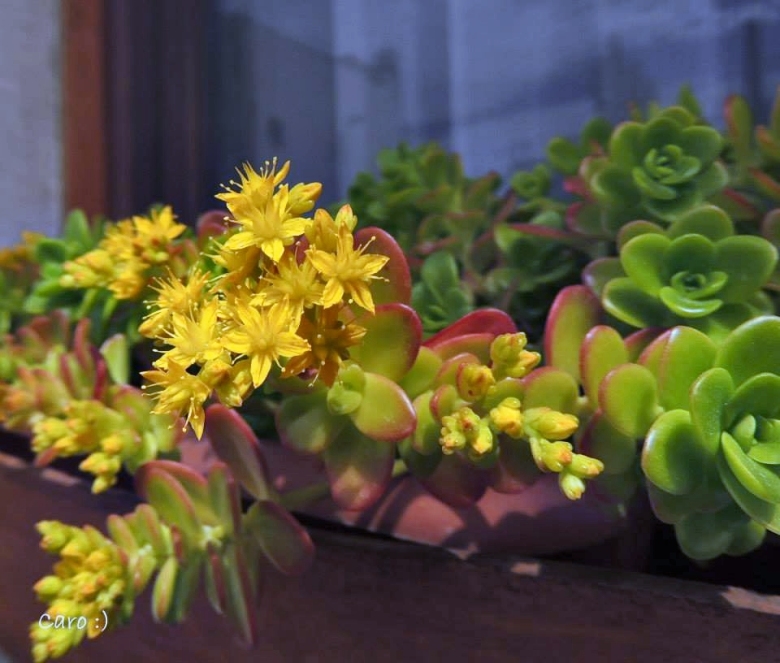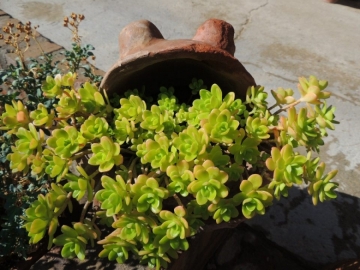




Your support is critical to our success.
Sedum N. Amer. 562. 1975 nom. inval. later homonym (non Lucé 1823)
Family: CRASSULACEAE
Accepted Scientific Name: Sedum kimnachii V.V.Byalt
Kew Bull. 43: 458 1999.

Origin and Habitat: Sedum kimnachiiSN|30949]]SN|30949]] has been described from a cultivated specimen, introduced into cultivation from Mexico (Northern America).
Synonyms:
- Sedum kimnachii V.V.Byalt
- Sedum clausenii V.V.Byalt
- Sedum decumbens R.T.Clausen
ENGLISH: Mexican sedum
Description: The Mexican sedum, Sedum kimnachiiSN|30949]]SN|30949]], is an outstanding succulent species that forms a flat, dense carpet of rounded glossy chartreuse leaves when grown in good soil with water; when deprived of a rich growing environment, the foliage takes on brilliant orange tones, especially in the winter. Numerous golden-yellow, slightly scented, flowers appear in clusters in spring to early summer, year after year.
Habit: It is a much-branched, perennial herb or subshrub often forming dense low mounds up to 1 metres across, glabrous throughout. It is evergreen so it doesn't lose its succulent thick leaves through the winter.
Stems: Creeping or sprawling, often rooting at nodes, decumbent, somewhat woody at base.
Leaves: Alternate, sessile or subsessile, fleshy and smooth, tending to cluster at stem tips into tight rosettes, usually 1.5–3.3 long, 1–2.7 cm wide and 1–3 mm thick, elliptic, broad-elliptic, elliptic-obovate, or suborbicular, flat, entire, shining green, sometimes with reddish brown flush on upper side and on margins towards the rounded apex.
Inflorescences: A terminal, more or less compact corymbose panicle with short erect to spreading branches, usually 4–6 cm high and 2-6 cm across. Bracts small and caducous, the lowest pair leaflike.
Flowers: 15–50, star shaped, orange-yellow, almost scentless or slightly perfumed, subsessile or with short pedicels, secund. Sepals somewhat unequal, 2.5–4.3 mm long, elliptic or elliptic-oblong. Petals 5, patent, 4–6 long, 2–3 mm wide, triangular, lanceolate or ovate, yellow, acute. Stamens 3–4.5 mm long, yellow. Carpels and styles yellow. Scales rectangular, often emarginate.
Fruits: Follicles.
Bibliography: Major references and further lectures
1) Sykes, W.R. 2005: “Corrected name: Sedum kimnachii Byalt.” New Zealand Botanical Society Newsletter 81: 13.
2) Webb, C.J.; Sykes, W.R.; Garnock-Jones, P.J. 1988: “Flora of New Zealand.” Vol. IV. Naturalised Pteridophytes, Gymnosperms, Dicotyledons. Botany Division, D.S.I.R., Christchurch, New Zealand as Sedum decumbens R.T.Clausen

Sedum decumbens (Sedum kimnachii) Photo by: Carolina González

Sedum decumbens (Sedum kimnachii) Photo by: Carolina González
Cultivation and Propagation: Sedum kimnachiiSN|30949]]SN|30949]] is an excellent groundcover plant with a beautiful apple-green foliage (orange-red and green in winter and in full sun) with clusters of golden-yellow flowers appearing in early summer. It is easily grown and can tolerate sun, shade, moist soils, dry soils, but looks its best only when given adequate light levels and water, and ideally should be grown outdoors in full sun. This plant is cultivated as an ornamental, it must be used like groundcover or be used in borders, and can be an attractive part of rock gardens between stepping stones or in wall niches in frost-free localities. In frost-prone areas it is great for containers/pots or hanging baskets.
Exposure: Generally speaking, the more light a plant gets the better it will display its colours and shape. Bright light is required to prevent "stretching" of sedums ("stretching" occurs when a moderately fast growing plant such as an Sedum, is grown in dim light or over-fertilized, which causes overly lush growth that contributes to weak, pallid plants). However, when moving plants from lower light conditions into full sun, be wary of sun scorch resulting from too rapid a transition into intense summer sunlight, most easily avoided by ensuring plants are well-watered before moving them on a cloudy day.
Waterings: Sedums are able to tolerate extended dry periods and survive drought without the need for watering, but they will grow stronger if they receive adequate moisture during their growing season, but never allowing the plant to remain waterlogged (root rot sensitive). Avoid overhead watering under humid conditions, especially during winter.
Soil: It is essential in cultivation to use a very porous soil, which will allow quick drainage. Sedums are shallow rooted plants, and therefore benefit from good levels of organic matter in the soil. Give it enough root space for optimum growth.
Fertilization: Slow release fertilisers with a low to moderate nitrogen content incorporated into the potting mix are usually adequate for the spring and summer growing seasons of Sedums, and additional fertiliser applications would not normally be required until spring.
Ventilation: Good air movement is important for minimising pest and disease risks, and avoiding excessive humidity in cool winter conditions is important to successfully growing Sedums in the nursery environment.
Hardiness: Can tolerate light frosts however, the ideal temperature range during the summer growing season is 5-25°C, with the cooler autumn temperatures tending to make their foliage colours become more intense than those of the active summer growing season. Long standing frost easily reduces the plant to mush. However live shoots often survive deep in the bush and the plant resumes from the base in spring.
Pests and diseases: Aphids like this plant (and all flowering sedums).
Propagation: It is easily propagated by cuttings in the spring. When the stem becomes too tall, just cut the top rosette with a piece of stem and plant it. It will soon take root, while the plant left with just the stem will soon grow new buds that can be in turn used for propagation. Time to take cuttings spring to early summer.
| Your Actions | |
|---|---|
| Back to Sedum index | |
| Back to Crassulaceae index | |
 |
Back to Succulents Encyclopedia index |
Privacy stantement - Terms and conditions - How to cite - About us - Feedback - Donate




